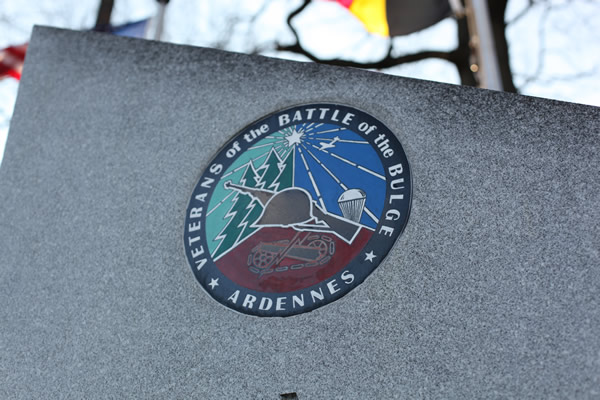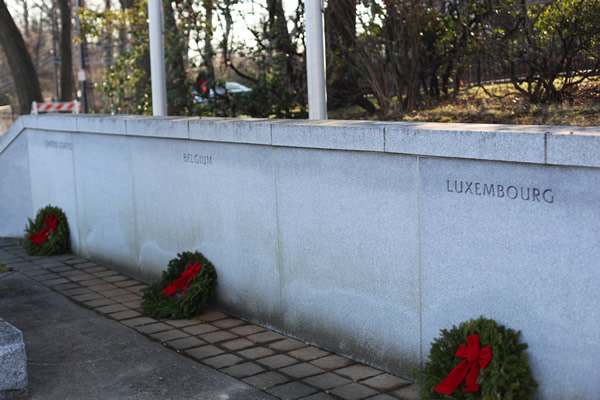For over a year now, I passed a sign for the Battle of the Bulge Monument on my way to work. I have yet to find anyone at work who visited it, but ironically, I never visited either. This past Friday, on the 67th anniversary of the start of the battle, I decided to check it out.

There are multiple signs pointing the way on King of Prussia Road and Lancaster Ave in the Radnor, PA area. All of them look the same.

The monument resides on the northern side of Eagle Rd at the Valley Forge Military Academy and College.
The site is certainly unique. The Luxembourg and Belgium flags flying next to the United States flag immediately struck me. Few may recall that men from both of those countries fought alongside Americans in the battle. We Americans have a bad habit of forgetting our allies when remembering battles. For example, few can recall that Brits, as well as Canadians, Australians, and Poles, also stormed the beaches of Normandy on D-Day.

From a distance, you can make out “A Triumph of Courage.” As you approach, you can clearly see the name of the battle, the war, and eventually the dates.

The importance of the battle in American memory is strong, as it was the last gasp of Hitler during World War II. By December 1944, the American and British advance toward Berlin had come to a halt, as had the Soviet advance from the east. Hitler took advantage of the lull to strike hard against the American lines in Belgium. He dubbed the operation “Autumn Mist” with the plan of striking at night in the fog and snow in order to nullify Allied airpower. By advancing all the way to the sea at the port of Antwerp and surrounding American forces in northern Belgium, he hoped to bring the western allies to terms. Hitler saw the Anglo-American-Soviet alliance as a fragile one and he believed if he could “deliver a few more heavy blows, then at any moment this artificially bolstered common front may suddenly collapse with a gigantic clap of thunder.” ((John Keegan, The Second World War (New York: Viking, 1990), 439-442.)) This is what Sun Tzu would describe as “disrupting alliances,” the second best approach to war (The Art of War, III.5). For Hitler though, it was far too late in the war to have the desired effect.
Hitler took up headquarters near the launch of the attack, providing personal direction of the operations. Attacking during a blizzard on December 16, Hitler successfully nullified Allied airpower initially. The bulk of the German attack pitted roughly 200,000 troops, 600 tanks, and 1,900 artillery pieces against an area defended by only 80,000 Americans and 400 tanks. The advance made it roughly 65 miles deep into American lines, but failed to capture any major objectives. The Americans put up stiff resistance, especially at Bastogne, and the Germans eventually ran out of fuel. By Christmas Eve, the advance came to a halt.
By January 15, 1945, Hitler realized the battle was lost, recalled the bulk of his forces, and returned to Berlin. However, the fighting continued for the pockets of Germans left in the “bulge” and the battle was not officially over until January 25. In the end, Americans suffered roughly 70,000 casualties compared to the Germans’ 80,000, making it the bloodiest battle of the war for the U.S. ((Details of the battle from Richard J. Evans, The Third Reich at War (New York: Penguin Books, 2010), 656-658.))
With that in mind, the monument features a quote from Winston Churchill (1874-1965), “This is undoubtedly the greatest American battle of the war, and will, I believe be regarded as an ever famous American victory.” (Read more about this Churchill quote)

At the top of the monument is the seal of the Veterans of the Battle of the Bulge.

The Delaware Chapter of this veteran group was responsible for doing the heavy lifting on raising funds to erect the monument. Below is a photo from the groundbreaking ceremony that took place on April 17, 1994 and included representatives from both Luxembourg and Belgium. Behind them is a model of the monument. ((“Battle of the Bulge Monument Groundbreaking Ceremonies,” The Bulge Bugle 13, no. 3 (August 1994), 21.))

Behind the monument is a wall that displays the country names under their respective flags. The veterans officially commissioned the monument on November 12, 1994, and they proudly hailed it as the first and only monument that also honors their Luxembourgish and Belgian allies. ((“A Triumph of Courage,” The Bulge Bugle 14, no. 1 (February 1995), 27.))

This past summer, I had the privilege of traveling to Belgium and Luxembourg where I met up with coworkers from both countries. It is an interesting thought that I am so close to such a unique monument in America that closely ties our countries together.
